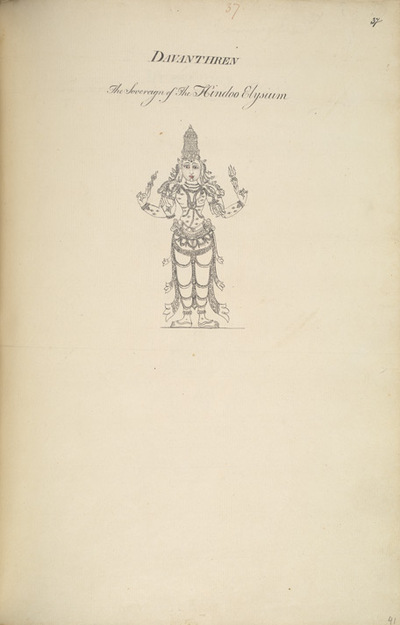Javascript must be enabled to continue!
Indra
View through Europeana Collections
Pen and ink drawing of Indra from the Minakshi
Sundareshvara Temple in Madurai, from an 'Album of 51 drawings (57
folios) of buildings, sculpture and paintings in the temple and
choultry of Tirumala Nayyak at Madura. c.1801-05', by an anonymous
artist working in the South India/Madurai style, c. 1801-1805. Each
picture is inscribed with a title and a number in ink.Construction
of the Minakshi Sundareshvara Temple complex was made possible by
the wealth and power of Tirumala Nayak (1623-1659). He was the most
prolific builder of a long line of Nayaka kings, a dynasty who
ruled a large portion of Tamil country in the 16th and 17th
centuries. The complex contains two main shrines; one dedicated to
Shiva and one to his consort Minakshi, an ancient local divinity.
Each shrine is set within its own walled complex containing several
subsidiary shrines, mandapams (assembly halls), courtyards and
galleries. Every available space is heavily ornamented with
magnificently sculpted figures of Hindu deities and portrait
sculptures of the Nayaka rulers. This drawing is of a detail on a
carved column that depicts Indra, an important divinity of Vedic
origin. He rides in a chariot drawn by two horses, his weapon is
the thunderbolt and he is said to have a 'thousand
eyes'.
Title: Indra
Description:
Pen and ink drawing of Indra from the Minakshi
Sundareshvara Temple in Madurai, from an 'Album of 51 drawings (57
folios) of buildings, sculpture and paintings in the temple and
choultry of Tirumala Nayyak at Madura.
c.
1801-05', by an anonymous
artist working in the South India/Madurai style, c.
1801-1805.
Each
picture is inscribed with a title and a number in ink.
Construction
of the Minakshi Sundareshvara Temple complex was made possible by
the wealth and power of Tirumala Nayak (1623-1659).
He was the most
prolific builder of a long line of Nayaka kings, a dynasty who
ruled a large portion of Tamil country in the 16th and 17th
centuries.
The complex contains two main shrines; one dedicated to
Shiva and one to his consort Minakshi, an ancient local divinity.
Each shrine is set within its own walled complex containing several
subsidiary shrines, mandapams (assembly halls), courtyards and
galleries.
Every available space is heavily ornamented with
magnificently sculpted figures of Hindu deities and portrait
sculptures of the Nayaka rulers.
This drawing is of a detail on a
carved column that depicts Indra, an important divinity of Vedic
origin.
He rides in a chariot drawn by two horses, his weapon is
the thunderbolt and he is said to have a 'thousand
eyes'.
Related Results
Indra Pays Homage to Krishna (painting, recto; text, verso), folio from a Bhagavata Purana series
Indra Pays Homage to Krishna (painting, recto; text, verso), folio from a Bhagavata Purana series
Based on chapter twenty-seven of the tenth book of the Bhagavata Purana, this folio depicts Indra, the king of the gods, paying homage to Krishna. The blue-skinned Krishna towers o...
Krishna Receives Homage from Indra (painting, recto), folio from a Bhagavata Purana series
Krishna Receives Homage from Indra (painting, recto), folio from a Bhagavata Purana series
Based on the narrative of chapter twenty-seven of the tenth book of the Bhagavata Purana, this folio depicts Indra, the king of the gods, paying homage to Krishna. Indra touches Kr...
Sculpture of Indrani at Jajpur, Orissa f.12
Sculpture of Indrani at Jajpur, Orissa f.12
Pen and ink drawing of a sculpture of Indrani
from Jajpur in Orissa, by an anonymous artist, taken from an album
of 37 drawings (43 folios) of sculpture at Jajpur, Puri, Bezwada
an...




